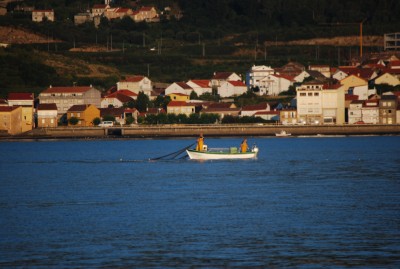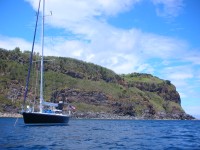
Aboard Aponivi
25 February 2011 | Charlestown, Nevis
29 December 2010 | Falmouth Harbor, Antigua
26 October 2010 | Palma
01 October 2010 | Ciutadella
19 September 2010 | Palma de Mallorca
07 September 2010 | Gibralter
28 August 2010 | Lagos
31 July 2010 | 41 22.34'N; 08 45.876'W
23 July 2010
16 July 2010
06 July 2010 | Brest
03 July 2010 | 54 13.424'N
25 June 2010 | Oban
25 June 2010 | Reported from Holyhead
08 June 2010 | Bngor Marina
08 June 2010 | Holyhead and Conway
31 May 2010 | Neyland, South Wales
13 April 2010
Close Call in Muros; All Well in Portugal
31 July 2010 | 41 22.34'N; 08 45.876'W
by H. Veisz

Laying Down Nets at Muros
We are in Povoa de Varzim, 30 miles south of the Rio Minho, the border between Spaain and Portugal. A few miles before we crossed from Spanish to Portugese waters we hit another milestone, exceeding 2,000 nautical miles this season.
The trip from La Coruna to Povoa was done in four short hops of 38 to 54 miles apeice. Along the way we spent one night at anchor off a small fishing village in the Ria de Camarinas; two nights at anchor off a similar village in the Ria de Muros; and one night at a marina in Baiona.
Both the winds and currents run southward along this coast, making the miles go quickly. The direction and speeds are so consstant that their description in a 2006 pilot book tends to be as accurate as the daily weather report. The Royal Cruising Club's guide to Atlantic Spain and Portugal states:
"In April, the prevailing northerly Portugese trades -- the Nortada -- begins to set in, generally blowing at around 15 - 25 knots (force 4 -6) and becoming more firmly established from north to south as the season advances ....
"Particular mention should be made of the strength of the afternoon sea breezes. From early summer onwards these start to blow around 1200 each day, regularly reaching 25 knots (force 6) and occassionally 30 knots (force 7) and continuing to blow until sundown....
"Winds are frequently stronger in river mouths, and in the lee of headlands (due to Katabatic effects) and allowance should be made for this if entering under sail."
An Iberian weatherman would not often go wrong by taping that forecast at the start of each season and playing it back every summer day. It perfectly describes the conditions we have experienced on three of our four coastal sailing days, and that we observed on other days. Only once, on the run from Baiona to Pavoa, did the winds break this pattern and take a day off, leaving us motoring on a barely rippled sea.
More often, we have been sailing at around eight knots, and have sometimes topped nine knots -- generally under one sail.
As the pilot book notes, the wind does not go out with a wimper. The hour before darkness (10:00 to 11:00 pm) is often the strongest, as we found out with nearly disasterous results at Muros. At 10:00 pm, we had been at anchor for three hours at the Ensenada de Muros, a recommended anchorage in the northwest corner of the broad Ria. Bucking Spanish tradition, Lorraine had already gone to bed. I was at the nav station, entering waypoints for the next leg and glancing at the wind and depth gauges -- wind because it was starting to howl, and depth because of slight concern that we may be left without an adequate safety margin as we reached low tide. Winds were hitting 28 knots, blowing from the north toward the fishing harbor's concrete breakwater to our south. Depth readings did not appear to be an issue. For a time, they did not go down as quickly as I had expected. Then they stopped going down at all. Then they started going up -- even though low tide was more than an hour away. It suddenly became clear that Aponivi was on the move, its anchor first draggng and then skipping over the bottom as the boat entered deeper water and gathered speed. I bolted topside andf saw that we had moved at least two hundred meters towared the breakwater from where we had anchored. I called Lorraine to action, calmly rejecting her request to change and assuring her that pajamas were the perfect attire for starting an engine and taking the wheel when being blown toward toward a concrete wall, and various rocks, in semi-darkness. During that exchange, we picked up more speed, bringing us more than half way to a hard landing. While Lorraine steered us back toward the anchorage, I hauled up the anchor. It reached the surface wrapped in a heavy tarp -- which had evidently prevented the plow from embedding itself in the sand -- and a number of discarded lines. I pulled the debris off the anchor with our boat hook, and we prepared to lower it once again. On the first try, it appeared to hold after a short while, but left us too far from shore. The third try did the trick.
Twelve hours later we felt comfortable enought to lower the dinghy and take it to the village of Muros. It is a picturesque little fishing village, surrounded by traditional family farms. The fishing fleet ranged from two-man dories to large trawlers. As we left the following morning (July 27)' we passed one of the dories deploying a net in the Ria, and passed a series of trawlers returning from sea.
[TO BE CONTINUED]
We are in Povoa de Varzim, 30 miles south of the Rio Minho, the border between Spaain and Portugal. A few miles before we crossed from Spanish to Portugese waters we hit another milestone, exceeding 2,000 nautical miles this season.
The trip from La Coruna to Povoa was done in four short hops of 38 to 54 miles apeice. Along the way we spent one night at anchor off a small fishing village in the Ria de Camarinas; two nights at anchor off a similar village in the Ria de Muros; and one night at a marina in Baiona.
Both the winds and currents run southward along this coast, making the miles go quickly. The direction and speeds are so consstant that their description in a 2006 pilot book tends to be as accurate as the daily weather report. The Royal Cruising Club's guide to Atlantic Spain and Portugal states:
"In April, the prevailing northerly Portugese trades -- the Nortada -- begins to set in, generally blowing at around 15 - 25 knots (force 4 -6) and becoming more firmly established from north to south as the season advances ....
"Particular mention should be made of the strength of the afternoon sea breezes. From early summer onwards these start to blow around 1200 each day, regularly reaching 25 knots (force 6) and occassionally 30 knots (force 7) and continuing to blow until sundown....
"Winds are frequently stronger in river mouths, and in the lee of headlands (due to Katabatic effects) and allowance should be made for this if entering under sail."
An Iberian weatherman would not often go wrong by taping that forecast at the start of each season and playing it back every summer day. It perfectly describes the conditions we have experienced on three of our four coastal sailing days, and that we observed on other days. Only once, on the run from Baiona to Pavoa, did the winds break this pattern and take a day off, leaving us motoring on a barely rippled sea.
More often, we have been sailing at around eight knots, and have sometimes topped nine knots -- generally under one sail.
As the pilot book notes, the wind does not go out with a wimper. The hour before darkness (10:00 to 11:00 pm) is often the strongest, as we found out with nearly disasterous results at Muros. At 10:00 pm, we had been at anchor for three hours at the Ensenada de Muros, a recommended anchorage in the northwest corner of the broad Ria. Bucking Spanish tradition, Lorraine had already gone to bed. I was at the nav station, entering waypoints for the next leg and glancing at the wind and depth gauges -- wind because it was starting to howl, and depth because of slight concern that we may be left without an adequate safety margin as we reached low tide. Winds were hitting 28 knots, blowing from the north toward the fishing harbor's concrete breakwater to our south. Depth readings did not appear to be an issue. For a time, they did not go down as quickly as I had expected. Then they stopped going down at all. Then they started going up -- even though low tide was more than an hour away. It suddenly became clear that Aponivi was on the move, its anchor first draggng and then skipping over the bottom as the boat entered deeper water and gathered speed. I bolted topside andf saw that we had moved at least two hundred meters towared the breakwater from where we had anchored. I called Lorraine to action, calmly rejecting her request to change and assuring her that pajamas were the perfect attire for starting an engine and taking the wheel when being blown toward toward a concrete wall, and various rocks, in semi-darkness. During that exchange, we picked up more speed, bringing us more than half way to a hard landing. While Lorraine steered us back toward the anchorage, I hauled up the anchor. It reached the surface wrapped in a heavy tarp -- which had evidently prevented the plow from embedding itself in the sand -- and a number of discarded lines. I pulled the debris off the anchor with our boat hook, and we prepared to lower it once again. On the first try, it appeared to hold after a short while, but left us too far from shore. The third try did the trick.
Twelve hours later we felt comfortable enought to lower the dinghy and take it to the village of Muros. It is a picturesque little fishing village, surrounded by traditional family farms. The fishing fleet ranged from two-man dories to large trawlers. As we left the following morning (July 27)' we passed one of the dories deploying a net in the Ria, and passed a series of trawlers returning from sea.
[TO BE CONTINUED]
Comments
| Vessel Name: | Aponivi |
| Vessel Make/Model: | Apogee 50 |
| Hailing Port: | New York, NY |
| Crew: | Howard and Lorraine Veisz |
Gallery not available

Who: Howard and Lorraine Veisz
Port: New York, NY